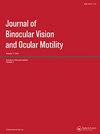波兰学童散光和佩戴眼镜的普遍程度
Q3 Medicine
Journal of Binocular Vision and Ocular Motility
Pub Date : 2023-08-01
DOI:10.1080/2576117X.2023.2237839
引用次数: 0
摘要
ABSTRACT 引言 单侧或不对称散光被认为是导致弱视的主要屈光不正,因此应在儿童时期定期进行眼科检查,以防止视力受损。本研究旨在评估波兰学童散光的发生率和眼镜佩戴情况。方法 对波兰 50 所学校 6 至 14 岁的儿童进行了横断面研究。散光通过非环视自屈光度进行评估,散光度数等于或大于 0.75 D 即为散光。根据学校所在地将儿童分为城市和农村两类。戴眼镜是指在学校戴眼镜。结果 研究共纳入 1041 名儿童,其中 52.3% 为女孩(n = 544)。平均年龄为 8.62±2.04 岁。散光发生率为 7.3%(95% 置信区间 [CI]:5.8-9.1%)。只有 21.7% 的散光儿童在学校戴眼镜。8.2%的男孩(95% 置信区间:6.0%-11.0%)和 6.4%的女孩(95% 置信区间:4.5%-8.8%;P = .13)被确诊为散光;19/76(25.0%)名散光儿童患有圆柱型散光(95% 置信区间:15.8%-36.3%)。最常见的散光是逆规则散光,在 48.7% 的散光儿童中出现,其次是顺规则散光(44.7%)和斜散光(6.6%)。散光的发生率与年龄不呈线性相关(r = 0.24; p = .53)。性别、年龄和居住地与散光的存在无明显关联。结论 本研究报告显示,散光在波兰学龄儿童中的发病率较低。然而,大多数散光儿童都未进行矫正。有必要开展进一步的纵向研究。本文章由计算机程序翻译,如有差异,请以英文原文为准。
The Prevalence of Astigmatism and Spectacle Wear in Polish Schoolchildren
ABSTRACT Introduction Unilateral or asymmetric astigmatism is considered a principal refractive error leading to amblyopia and regular eye examinations should be carried out during childhood to prevent visual impairment. The aim of this study was to evaluate the prevalence of astigmatism and spectacle wear among Polish schoolchildren. Methods A cross sectional study was carried out in children aged 6 to 14 years old from 50 schools in Poland. The presence of astigmatism was assessed by non-cycloplegic autorefraction, and defined as a cylinder equal or greater than 0.75 D. Children were classified as living in urban or rural areas according to the school location. Spectacle wear was defined as having spectacles at school. Results The study included 1041 children and 52.3% were girls (n = 544). The mean age was 8.62 ± 2.04 years. The prevalence of astigmatism was 7.3% (95% confidence interval [CI]: 5.8–9.1%). Only 21.7% of children with astigmatism wore spectacles at school. Astigmatism was diagnosed in 8.2% of boys (95% CI: 6.0–11.0%) and 6.4% of girls (95% CI: 4.5–8.8%; p = .13); cylindrical anisometropia was present in 19/76 (25.0%) of children with astigmatism (95% CI: 15.8%–36.3%). Against-the-rule astigmatism was the most common; it was observed in 48.7% of children with astigmatism, followed by with-the-rule astigmatism (44.7%) and oblique astigmatism (6.6%). The prevalence of astigmatism was not linearly correlated with age (r = 0.24; p = .53). Gender, age and place of living were not significantly associated with the presence of astigmatism. Conclusions This study reports a low prevalence of astigmatism in Polish school children. However, the majority of children with astigmatism were uncorrected. Further longitudinal studies are warranted.
求助全文
通过发布文献求助,成功后即可免费获取论文全文。
去求助
来源期刊

Journal of Binocular Vision and Ocular Motility
Medicine-Ophthalmology
CiteScore
1.20
自引率
0.00%
发文量
42
 求助内容:
求助内容: 应助结果提醒方式:
应助结果提醒方式:


